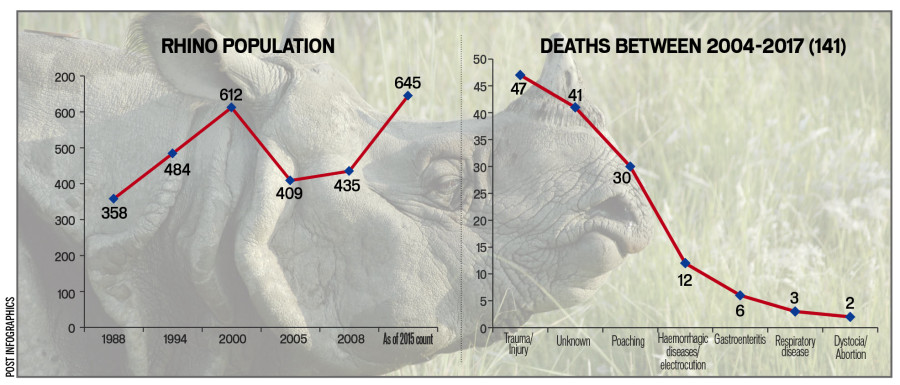Climate & Environment
National rhino census set to start from mid-March
This is for the first time the government is spending its own fund to count the rhino population.
Chandan Kumar Mandal
The government is planning to count the number of one-horned rhinos in the country from mid-March.
The Department of National Park and Wildlife Conservation—the government agency responsible for the management of the country’s protected areas—has intensified its preparation for rhino census in various parks.
The last time the rhino population was counted was in 2015.
According to Bishnu Prasad Shrestha, a spokesperson with the department, ground preparations have already started.
“Protected areas have started homework about how the counting will be conducted inside the parks,” Shrestha told the Post. “We have not fixed a particular date yet, but the counting will begin tentatively by the Nepali month of Chaitra.”
The department is developing an implementation plan which will include the overall timeline and strategies for conducting the count. Likewise, the formation of two committees—technical and advisory—which will be overseeing the work on the ground, types of equipment and human resources required for the purpose, among other requirements, is underway in Kathmandu.
“We will need to provide orientation training to the manpower who will be involved in the census. Elephants to be used for rhino counting are ready while new elephants are also being trained to walk on the track,” said Shrestha.
The upcoming national rhino census inside the country’s protected areas and adjoining forests areas is also significant for the country because this is for the first the time state is using its own budget.
The government has allocated over Rs11 million for the census, whereas other technical supports will be accepted from donor agencies. Nepal formally started conservation of rhinos by establishing Chitwan Sanctuary—now Chitwan National Park— in 1973, after a massive drop in rhino population during the 1950s and 60s.
The rhino count, which was initially planned for last year, was postponed because of the fund crunch.
“The rhino conservation action plan says rhino counting can be done in every four or five years. The census in Nepal was delayed due to the lack of fund,” said Shrestha.
According to the 2015 count, Nepal is home to 645 rhinos—605 in Chitwan, 29 in Bardiya National Park, eight in Shuklaphanta National Park, and three in Parsa National Park.
The upcoming rhino count report is also important, as it will be the first census after an alarming rise in rhino deaths reported in the last few years when the incidents of rhino poaching were largely under control.
In the fiscal year 2016-17, there were 25 incidents of rhino death, including one killed by poachers—the first instance of poaching in the last five years. A total of 26 rhinos died inside the park in 2017-18.
The last fiscal year 2018-19 emerged as one of the worst years for rhino conservation in the country where the endangered great one-horned rhinoceros continued to die throughout the year.
According to the data of Chitwan National Park, 46 one-horned rhinos died last year in and around the park—the highest rhino mortality for the park in a year due to natural causes. Following the massive death, the department also launched a study to measure the carrying capacity of the Chitwan National Park.
“Birth and death of rhinos are natural processes. Last year, there was a surge in natural deaths of rhinos, but there must have been new rhinos born in the period. We have brought down poaching incidents to zero,” said Shrestha. “The upcoming census is definitely important for us as its outcome will guide the government in designing its future rhino conservation strategy for at least the next five years.”




 8.12°C Kathmandu
8.12°C Kathmandu











